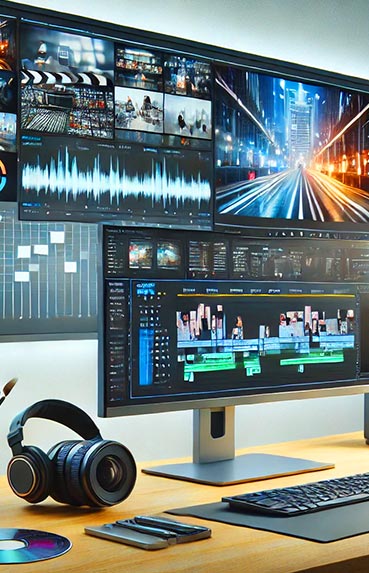In today's digital era, YouTube has established itself as one of the most influential and accessible platforms for creating and distributing audiovisual content. With over 2 billion active monthly users, the opportunity to reach a global audience is undeniable. However, starting a YouTube channel goes beyond simply uploading videos. It involves planning, strategy, and a clear understanding of the tools and techniques needed to stand out. This article will guide you through the process of creating your own online video channel on YouTube, providing practical tips and concrete examples to help you succeed.
Planning and Strategy
Defining Purpose and Audience
Before creating content, it's crucial to define the purpose of your channel. Ask yourself: What do I want to achieve with my channel? and Who do I want to reach? Clarity in these areas will help you stay focused and attract the right audience.
Channel Purpose: Determine if your channel will be educational, entertaining, informative, or a combination of these. For example, if you want to share cooking tutorials, your purpose could be to educate the audience about culinary techniques.
Target Audience: Research and understand who your ideal viewers are. Consider factors such as age, interests, and geographic location. Use tools like Google Trends or YouTube Analytics to identify trends and preferences of your target audience.
Competitor Research
Analyze other channels similar to the one you want to create. Observe what type of content they are producing, how they interact with their audience, and what monetization strategies they use. This will not only give you ideas but also help you identify gaps in the market that you could fill with your unique content.
Case Studies: Look at successful and less successful channels in your niche. Identify what they are doing well and what could be improved. Learn from their successes and mistakes.
Differentiation: Think about how you can offer something different or add unique value. This could be through a distinctive presentation style, deeper content, or a unique perspective.
Channel Setup
Creating a YouTube Account
To get started, you need to create a Google account if you don't already have one. This account will allow you to access YouTube and set up your channel.
Google Registration: Visit the Google account creation page and follow the instructions to set up your account.
Access YouTube: Once you have a Google account, sign in to YouTube and select "Your channel" from the dropdown menu.
Channel Customization
Customization is key to creating a recognizable and professional visual brand.
Profile Picture and Banner: Use high-quality images that represent your channel. The banner should be eye-catching and contain relevant information, such as the channel name and a slogan.
Channel Description: Write a clear and concise description explaining what your channel is about. Include relevant keywords to improve visibility in search engines.
Social Media Links: Add links to your social media profiles to increase interaction and build a wider community.
Content Creation
Developing Ideas and Scripts
Creating engaging content starts with a good idea. Brainstorm topics that are relevant to your audience and aligned with the purpose of your channel.
Brainstorming: Use tools like AnswerThePublic or BuzzSumo to explore what questions people are asking in your niche.
Scripts: Writing a script will help you stay focused and ensure your message is conveyed clearly. Not all videos require a detailed script, but having a basic outline can be very helpful.
Video Production and Editing
Video quality is crucial for retaining viewers. While you don't need high-end equipment to start, there are certain aspects you shouldn't overlook.
Basic Equipment: A good camera, microphone, and editing software are essential. You can start with a quality smartphone and upgrade your equipment as your channel grows.
Lighting and Sound: Ensure your videos are well-lit and the sound is clear. These two elements are fundamental for an enjoyable viewing experience.
Editing Software: Use programs like Adobe Premiere Pro, Final Cut Pro, or DaVinci Resolve to edit your videos. Learn to cut clips, add transitions, and enhance audio.
Note: Consistency in producing and publishing content is key to keeping your audience engaged. Set a publishing schedule and stick to it.
Optimization and Publishing
YouTube SEO
SEO (Search Engine Optimization) is essential for increasing the visibility of your videos on YouTube. A good SEO strategy will help you reach a broader audience.
Keywords: Research and use relevant keywords in your video titles, descriptions, and tags. Tools like TubeBuddy and VidIQ can help you find the best keywords for your niche.
Attractive Thumbnails: Design eye-catching thumbnails that grab users' attention. Use bright colors, clear text, and an image that represents the video content.
Playlists: Organize your videos into playlists to enhance the user experience and increase watch time.
Publishing and Promotion
Once your video is ready, it's time to publish and promote it to reach as many people as possible.
Share on Social Media: Spread your videos on platforms like Facebook, Instagram, and Twitter. Social media is an excellent way to extend your content's reach.
Collaborations: Consider collaborating with other content creators in your niche. Collaborations can help you reach new audiences and strengthen your network.
Audience Interaction: Respond to comments and actively engage with your community. Interaction increases audience loyalty and improves your channel's visibility.
Analysis and Continuous Improvement
Using YouTube Analytics
YouTube offers detailed analytics tools that allow you to better understand your video's performance and audience behavior.
Key Metrics: Look at metrics like watch time, retention rate, and traffic sources. This data will help you adjust your content and strategies.
A/B Testing: Experiment with different types of content, formats, and styles to see what resonates most with your audience.
Adaptation and Evolution
Success on YouTube requires adaptability and a willingness to evolve over time. Stay up to date with trends and changes in YouTube's algorithm to ensure your content remains relevant.
Audience Feedback: Listen to your viewers' opinions and use their feedback to improve your videos.
Continuous Learning: Take advantage of educational resources available online, such as courses and tutorials, to keep improving your production and marketing skills.
By following these steps and tips, you'll be well on your way to creating a successful and rewarding YouTube channel. Remember that patience and perseverance are key, as growth on YouTube requires time and effort. With dedication and creativity, you can build a vibrant community and achieve your goals on the platform.

















